- 1862 Sharps & Hankins Naval Carbine
- Sharps & Hankins Carbine, Shoulder Stock
- Sharps & Hankins Carbine, Barrel Leather Sleeve
- Sharps & Hankins Carbine, Breech Section
- Sharps & Hankins Carbine, Breech Left Side
- Sharps & Hankins Carbine, Open Breech
- 1862 Sharps & Hankins Carbine, Rear Sight
- Sharps & Hankins Carbine, Front Sight
- 1862 Sharps & Hankins Carbine, Open Slide Breech
- Sharps & Hankins Carbine, Safety & Hammer
So on to the next weapon in my Civil War Arsenal. I’ve been of the fence as to which weapon I’d write about next, so I decided to write about the New Model 1862 Sharp & Hankins Naval Carbine.
Christian Sharps left the Sharps Rifle Company in 1853 and started his own company. He needed capital to expand his operation so he brought in partners Ira B. Ebby and Natan H. Bolles. The Companies name was C. Sharps & Company.
In 1860 William C. Hankins, a wood maker by trade joined the firm as superintendent of the rifle works. He brought additional capital to the business, which was greatly needed. In 1861 Ira and Nathan left the firm, the following year William became a full partner. In 1863 the Company’s name was changed to Sharps & Hankins.
The Sharps & Hankins Carbine contained a number of “firsts” in the military field.
1. The separate firing pin within the receiver.
2. Hammer safety mechanism, this kept the hammer face from contacting the firing pin.
3. Extractor system, a spring loaded catch in the frame extracts the cartridge and also prevents the forward movement of the cartridge case when the breech is open.
The Sharps & Hankins Carbine used a 52 – 56 rimfire cartridge with the later carbines chambered for Spencer rimfire cartridges. It had a 800 yard graduated rear sight with a walnut stock the overall length of the carbine is 38 5/8”long and the Barrel is 23 5/8”long. But perhaps the strangest thing about this weapon is that it has a leather sleeve that fits over the barrel and is fastened at the breech. Because this was designed for Naval use it was thought that the leather would prevent the barrel from rusting from exposure to salt water, however they found that when the leather got wet it held the water (like a sponge) and rusted the barrel, part of the learning curve of the industrial revolution I guess.
They actually made a Calvary version of this Carbine without the leather sleeve over the barrel. This carbine measured a total of 33 ½ “with the barrel length of 18 ¾”. It had a sling ring on the left side of the breech so the cavalrymen could attach it to there harness.
About 6200 of these were made throughout the war at a cost of $25.00 each. There were only a handful (600 I think) of the Calvary version made.
The one you see here is a 1900 serial # and is in good condition. Most of the bluing has worn off but it has no rust on it. The leather is in very good condition but may have been replaced at some time. On most of these Navy Carbines the leather sleeve is in poor condition or even missing
The Sharps & Hankins Co. closed its doors in 1867 and all guns were sold off by 1868. William Hankins left the firm early 1867 and the Company changed its name to C. Sharps & Co.
Christian Sharps (who by the way patented the breech mechanism on the Sharps Carbine) died of tuberculosis on March 12, 1874 his estate was valued at $341.25.

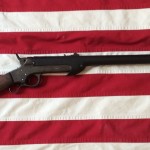
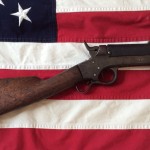
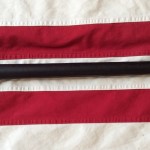
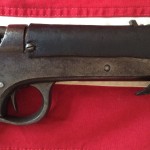
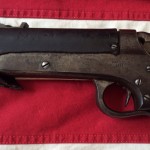
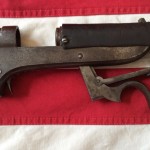
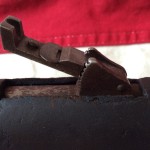
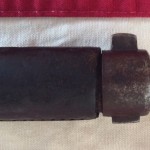
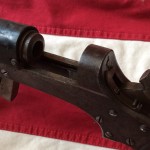
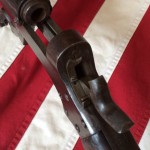
Dear Gene,
I would like to sell my Sharps Carbine. I’d say it’s in fair condition. Any thoughts on it’s value and where I might sell it, are much appreciated.
Kindly Yours,
Steve
Steve, please provide serial number it located on the tang behind the breech…….where you would grip the weapon as your firing it……
Gene
It’s almost impossible to give valuations without handling the weapon, however if you provide more images of the Carbine…..left and right side, closeups of the Lock Plate and breech Block, barrel, shoulder stock and any markings or cartouches…….I will do my best in estimating value.
Regards, Gene
ive also got a sharps carbine, i am looking for the leather to cover the barrel, does anyone have one out there ? you can contact me on facebook and ive got a page called bryndons guns
I’m not certain if your Sharps & Hankins Carbine is a Navy Model…..only Navy models had the leather cover on the barrel, this was suppose to prevent the barrel from rusting however when it got wet with salt water that’s exactly what it did……rust.
If your Carbine has a sling ring on the left side you have a cavalry type, these barrels were either blued or tinned……no leather sleeve was covering the barrel……
I have a sharps Hankins Model that is center fire, Nickle plated and leather only at left hand position. It is not mortified as it has no holes or indications of them. I have a feeling this is a proto type.
Mr. West
I am trying to estimate the value of my, I believe, dug Enfield rifle which I dug a number of years ago from a dry creek bed in Fredericksburg, VA. I found the entire riffle with the exception of the wood. How would I attach a photo?
Thank you
Ron
Ron, please send image of relic to my email at civilwararsenal@yahoo.com and I will do my best to answer any questions you have.
Regards Gene West